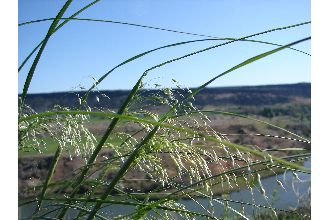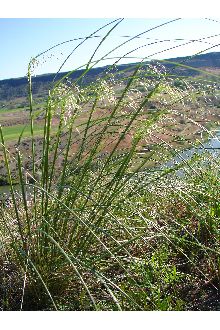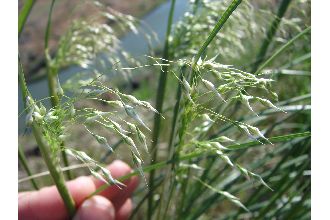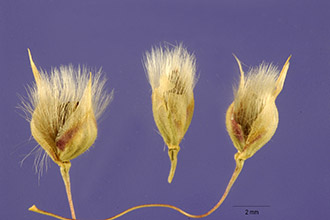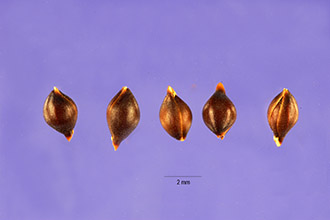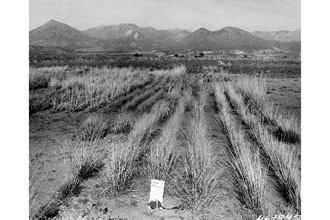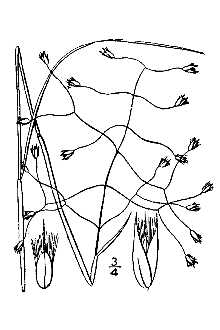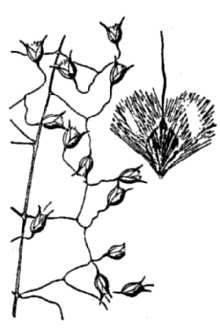Oryzopsis hymenoides (Roem. & Schult.) Ricker ex Piper
Scientific Name: Oryzopsis hymenoides (Roem. & Schult.) Ricker ex Piper
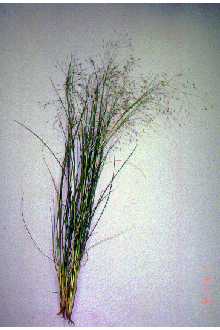
| General Information | |
|---|---|
| Usda Symbol | ORHY |
| Group | Monocot |
| Life Cycle | Perennial |
| Growth Habits | Graminoid |
| Native Locations | ORHY |
Plant Guide
Alternate Names
Oryzopsis hymenoides, Stipa hymenoides
Uses
Ethnobotanic: The nutritious seed of Indian ricegrass was one of the staple foods of American Indians. Grazing/rangeland/hayland: Indian ricegrass is highly palatable to livestock and wildlife. It is a preferred feed for cattle, horses and elk in all seasons. It is considered a preferred feed for sheep, deer and antelope in spring and a desirable feed for sheep, deer, and antelope in late fall and winter. It reaches its peak production from mid-June through mid-July. It holds its nutrient value well at maturity. It is not considered valuable as a hay species. Erosion control/reclamation: One of Indian ricegrass' greatest values is for stabilizing sites susceptible to wind erosion. It is well adapted to stabilization of disturbed sandy soils in mixes with other species. It is naturally an early invader onto disturbed sandy sites (after and in concert with needle and thread grass). It is also one of the first to establish on cut and fill slopes. It does not compete well with aggressive introduced grasses during the establishment period, but is very compatible with slower developing natives, such as Snake River wheatgrass (Elymus wawawaiensis), bluebunch wheatgrass (Pseudoroegneria spicata), thickspike wheatgrass (Elymus lanceolata ssp. lanceolata), streambank wheatgrass (Elymus lanceolata ssp. psammophila), western wheatgrass (Pascopyrum smithii), and needlegrass species (Stipa spp. and Ptilagrostis spp.). Drought tolerance combined with fibrous root system and fair to good seedling vigor, make Indian ricegrass desirable for reclamation in areas receiving 8 to 14 inches annual precipitation. @ Grass Images Bioinformatics Working Group Texas A&M University Wildlife: Forage value is mentioned in the grazing/rangeland/hayland section above. Due to the abundance of plump, nutritious seed produced by Indian ricegrass, it is considered an excellent food source for birds, such as morning doves, pheasants, and songbirds. Rodents collect the seed for winter food supplies. It is considered good cover habitat for small animals and birds. Beautification: Due to its attractive seed heads, Indian ricegrass is recommended for roadside, campground, and other low rainfall locations for beautification.
Status
Please consult the PLANTS Web site and your State Department of Natural Resources for this plant’s current status, such as, state noxious status, and wetland indicator values.
Description
General: Grass Family (Poaceae). Indian ricegrass is 8 to 30 inches tall. It has many tightly rolled, slender leaves, growing from the base of the bunch giving it a slightly wiry appearance. The ligule is about 6 mm long and acute. It has a wide spreading panicle inflorescence with a single flower at the end of each hair-like branch. Seeds are round to elongated, black or brown, and generally covered with a fringe of short, dense, white callus hairs. Indian ricegrass has fair to good seedling vigor. Seed of most accessions are very slow to germinate due a thick hull and embryo dormancy.
Distribution
Indian ricegrass is a widely distributed, short to medium lived, native, cool-season bunchgrass generally found in the plains, foothills, mountains, and intermountain basins of the western United States on dry and primarily loamy-sandy-gravelly sites. For current distribution, please consult the Plant Profile page for this species on the PLANTS Web site.
Establishment
Adaptation: Indian ricegrass is very winter hardy and has a broad climatic adaptation, It can be found at elevations from 2,000 up to 10,000 feet, It grows best in areas with average annual precipitation of 8 inches to above 14 inches, It has been seeded in areas with as low as 6 inches of rainfall and reproduced, It is also found on sites with precipitation well above 14 inches, It prefers sandy course textured soils in its southern areas of adaptation and can be found on sands, fine sandy loams, silt loams, clay loams, gravelly, rocky, to shale areas in the mid-northern areas of its adaptation, It does well on hot, dry southern exposures, In Colorado, Utah, Nevada, and locations to the south, ‘Nezpar’ does best above 6500 feet elevation and ‘Paloma’ does best below 6500 feet elevation, Indian ricegrass is often an early seral or pioneer species establishing seedlings in open or disturbed sites and on sandy soils, It is relatively short-lived for a perennial grass and reproduces by seed, It does not tolerate poorly drained soils, extended periods of inundation, winter flooding or shading, It is tolerant of weakly saline and sodic conditions, but prefers neutral soils, It can also tolerate fire later in the growing season and when the plant is dormant without serious damage, Species often associated with Indian ricegrass include the big sagebrush (Artemisia tridentata) complex, saltbush species (Atriplex spp,), winterfat (Krascheninnikovia lanata), juniper species (Juniperus spp,), needle and thread (Stipa comata) and other needlegrasses, bluebunch wheatgrass, Snake River wheatgrass, thickspike wheatgrass, streambank wheatgrass, western wheatgrass, and blue grama (Bouteloua gracilis), B&W Texas A&M University Planting: This species should be seeded with a deep furrow drill at a depth of 1/2 to 1 inch on medium to fine textured soils and 1 to 3 inches on coarse textured soils, A deeper planting depth puts the seed in contact with moist soil conditions, which aids in the stratification process and makes the seed less likely to be dug up by rodents, Use soil moisture sensors to measure the soil moisture of Oryzopsis hymenoides (Roem. & Schult.) Ricker ex Piper., Use of older seed up to 4 to 6 years of age may improve germination and should be planted at 1/2 to 1-inch depth, Seed may require acid washing to scarify the seed and improve germination, Single species seeding rate recommended for Indian ricegrass is 8 pounds Pure Live Seed (PLS) per acre or 24 PLS per square foot or 24 PLS seeds per linear row foot at 12 inch row spacing, If used as a component of a mix, adjust to percent of mix desired, For rangeland mixtures, approximately 30 to 50 percent of the mix or 2,5 to 4 pounds PLS/acre should be considered, For mined lands and other harsh critical areas, the seeding rate should be doubled, Two separate seeding operations may be necessary when planting seed mixes, because most species should be planted at shallower depths than those recommended for Indian ricegrass, This means that Indian ricegrass should be planted first, followed by the seeding operation for the rest of the mix, The best seeding results are obtained from seeding in very early spring on heavy to medium textured soils and in late fall on medium to light textured soils, Dormant fall seeding may improve germination of dormant seeds, Summer and late summer (June - September) seedings are not recommended, Seedling vigor is fair to good, but the seed may have a high percentage of hard seed, and stands may take 2 to 5 years to fully establish, Indian ricegrass stands respond well to light irrigation and light fertilization, Stands may require weed control measures during establishment, Bromoxynil may be applied at the 3-4 leaf stage for early suppression of young broadleaf weeds and application of 2,4-D should not be made until plants have reached the 4-6 leaf stage or later, Mow when weeds are beginning to bloom to reduce weed seed development, Grasshoppers may damage new stands and other insects and use of pesticides may be required, All herbicides and pesticides should be applied according to the label,
Management
Indian ricegrass establishes slowly and new seedings should not be grazed until at least late summer or fall of the second growing season. It makes its initial growth in early spring and matures seed by mid summer. New stands should not be grazed until the plants are reproducing by seed. Indian ricegrass benefits from grazing use if it is moderately grazed in winter and early spring. Livestock should be removed while there is still enough growing season moisture to allow recovery, growth, and production of seed. Stands will deteriorate under heavy spring grazing systems. The third and fourth years following establishment may be critical to stand survival. Reproduction is dependent on seed production and quality seed in the soil bank must be available as mature plants begin to go out of the stand. Grazing management with rest or deferment schedules that allow plants to produce seed every 2 to 3 years is recommended. By the eighth or ninth year following establishment, the seed bank should be adequate, with a wide variation of low dormancy to hard seed to ensure long term stand survival with proper grazing management. Environmental Concerns: Indian ricegrass is relatively short-lived and spreads via seed distribution. It is not considered "weedy" or an invasive species, but can spread into adjoining vegetative communities under the proper management, climatic, and environmental conditions. Most seedings do not spread from original plantings, or if they do spread, the rate of spread is not alarming. Indian ricegrass is self-pollinated, but may occasionally be pollinated by native needlegrass species. These natural crosses generally produce sterile hybrids.
Seed Production
Seed production of Indian ricegrass has been very successful under cultivated conditions. Row spacing of 24 inches under irrigation or high precipitation (4.0 pounds PLS per acre) to 36 inches on dryland (3.0 pounds PLS per acre) is recommended. Cultivation will be needed for weed control and to maintain row culture. Seed fields are productive for about five years. Fall moisture, soil fertility, and plant re-growth determine the succeeding years yield. Birds will feed on seed, and wind can shatter seed from inflorescence prior to harvest. Average production of 100 to 200 pounds per acre can be expected under dryland conditions in 14 inch plus rainfall areas. Average production of 300 to 400 pounds per acre can be expected under irrigated conditions. Harvesting can be completed by direct combining in the hard dough stage or by wind-rowing. Windrowing helps ensure a more complete threshing. Indian ricegrass is so indeterminate that windrowing allows final curing in the swath prior to combining. Windrowing also reduces the risk of wind damage. It is very difficult to thrash all the seed if direct combined, and it may be beneficial to re-thrash windrows after a few days for seed not threshed in the first operation. Seed heads have moderate to high rates of shatter and require close scrutiny of maturing stands. Seed is generally harvested in early July to early August. Seed must be dried immediately after combining (moisture content should be 12 percent in bins/15 percent in sacks). Cultivars, Improved and Selected Materials (and area of origin) Foundation and registered seed is available through the appropriate state Crop Improvement Association or commercial sources to grow certified seed. ‘Nezpar’ Indian ricegrass was originally collected in 1935 from a site south of White Bird, Idaho by the Washington Plant Materials Center (PMC) staff. It was selected from 152 accessions for its vegetative characteristics and low seed dormancy by the Idaho PMC and released in 1978. It is adapted to the Northwest and Intermountain regions where precipitation averages 8 inches or above. It has survived in plantings with 6 inches annual rainfall. It prefers gravelly to loamy to sandy soils. It is noted for its large erect plant type, robust stems, abundant leaves, medium to small dark nearly hairless elongated seeds (< 50 percent dormant seeds), and good to excellent seedling vigor. Certified seed is available, and Aberdeen PMC maintains breeder seed. 'Paloma' Indian ricegrass was collected in 1957 west of Pueblo, Colorado at about 5000 feet elevation on medium soils. It was selected by New Mexico PMC and released cooperatively by the PMC and New Mexico Agricultural Extension Service in 1974. It is adapted to the Southwestern Regions of the Western United States. It is considered very drought tolerant, has good seedling vigor, forage, seed yields, and is long lived. Paloma has good regrowth and spring recovery. It is considered the best Indian ricegrass cultivar for the Southwestern Regions of the Western United States. Certified seed is available, and Los Lunas PMC maintains breeder seed. 'Rimrock' Indian ricegrass was collected in 1960 from a native site averaging 10 to 14 inches of precipitation, north of Billings, Montana, at about 3600 feet elevation on sandy soils. The Montana PMC; ARS, Logan, Utah; and the Montana and Wyoming Agricultural Experiment Stations released Rimrock in 1996, primarily because of its ability to retain mature seed better than Nezpar or Paloma. Its more acute angle of glumes helps retain seed longer and protects it from seed shatter caused by wind and/or rain. Certified seed is available, and Bridger PMC maintains breeder seed.
Plant Traits
Growth Requirements
| Fertility Requirement | Low |
|---|---|
| Cold Stratification Required | Yes |
| Cold Stratification Required | Yes |
| Cold Stratification Required | Yes |
| Cold Stratification Required | Yes |
| Drought Tolerance | High |
| Drought Tolerance | High |
| Drought Tolerance | High |
| Drought Tolerance | High |
| Fertility Requirement | Low |
| Fertility Requirement | Low |
| CaCO3 Tolerance | High |
| Fertility Requirement | Low |
| Fire Tolerance | High |
| Fire Tolerance | High |
| Fire Tolerance | High |
| Fire Tolerance | High |
| Frost Free Days, Minimum | 110 |
| Frost Free Days, Minimum | 90 |
| Frost Free Days, Minimum | 90 |
| Frost Free Days, Minimum | 90 |
| Adapted to Medium Textured Soils | Yes |
| Adapted to Coarse Textured Soils | Yes |
| Adapted to Coarse Textured Soils | Yes |
| Adapted to Coarse Textured Soils | Yes |
| Adapted to Coarse Textured Soils | Yes |
| Adapted to Fine Textured Soils | No |
| Adapted to Fine Textured Soils | No |
| Adapted to Fine Textured Soils | No |
| Adapted to Fine Textured Soils | No |
| Adapted to Medium Textured Soils | Yes |
| Temperature, Minimum (°F) | -43 |
| Adapted to Medium Textured Soils | Yes |
| Adapted to Medium Textured Soils | Yes |
| Anaerobic Tolerance | Medium |
| Anaerobic Tolerance | None |
| Anaerobic Tolerance | None |
| Anaerobic Tolerance | None |
| CaCO3 Tolerance | High |
| CaCO3 Tolerance | High |
| CaCO3 Tolerance | High |
| Salinity Tolerance | Low |
| Precipitation, Minimum | 6 |
| Precipitation, Minimum | 6 |
| Precipitation, Minimum | 8 |
| Precipitation, Minimum | 8 |
| Root Depth, Minimum (inches) | 18 |
| Root Depth, Minimum (inches) | 18 |
| Root Depth, Minimum (inches) | 18 |
| Root Depth, Minimum (inches) | 18 |
| Salinity Tolerance | Low |
| Hedge Tolerance | None |
| Salinity Tolerance | Low |
| Salinity Tolerance | Low |
| Shade Tolerance | Intolerant |
| Shade Tolerance | Intolerant |
| Shade Tolerance | Intolerant |
| Shade Tolerance | Intolerant |
| Temperature, Minimum (°F) | -33 |
| Temperature, Minimum (°F) | -36 |
| Temperature, Minimum (°F) | -43 |
| Precipitation, Maximum | 16 |
| Hedge Tolerance | None |
| Hedge Tolerance | None |
| Hedge Tolerance | None |
| Moisture Use | Low |
| Moisture Use | Low |
| Moisture Use | Low |
| Moisture Use | Low |
| pH, Maximum | 8.6 |
| pH, Maximum | 8.6 |
| pH, Maximum | 8.6 |
| pH, Minimum | 6.6 |
| pH, Minimum | 6.6 |
| pH, Minimum | 6.6 |
| pH, Minimum | 6.6 |
| Precipitation, Maximum | 16 |
| Precipitation, Maximum | 16 |
| Precipitation, Maximum | 16 |
| pH, Maximum | 8.6 |
Morphology/Physiology
| Resprout Ability | No |
|---|---|
| Resprout Ability | No |
| Resprout Ability | No |
| Shape and Orientation | Erect |
| Shape and Orientation | Erect |
| Shape and Orientation | Erect |
| Shape and Orientation | Erect |
| Toxicity | None |
| Toxicity | None |
| Toxicity | None |
| Toxicity | None |
| Active Growth Period | Spring, Summer, Fall |
| Flower Conspicuous | No |
| Fall Conspicuous | No |
| Fire Resistant | No |
| Fire Resistant | No |
| Fire Resistant | No |
| Fire Resistant | No |
| Flower Color | Yellow |
| Flower Color | Yellow |
| Flower Color | Yellow |
| Flower Color | Yellow |
| Flower Conspicuous | No |
| Flower Conspicuous | No |
| Fall Conspicuous | No |
| Flower Conspicuous | No |
| Foliage Color | Green |
| Foliage Color | Green |
| Foliage Color | Green |
| Foliage Color | Green |
| Foliage Porosity Summer | Moderate |
| Foliage Porosity Summer | Moderate |
| Foliage Porosity Summer | Moderate |
| Foliage Porosity Summer | Moderate |
| Foliage Porosity Winter | Porous |
| Foliage Porosity Winter | Porous |
| Bloat | None |
| Resprout Ability | No |
| Active Growth Period | Spring, Summer, Fall |
| Active Growth Period | Spring, Summer, Fall |
| Active Growth Period | Spring, Summer, Fall |
| After Harvest Regrowth Rate | Moderate |
| After Harvest Regrowth Rate | Moderate |
| After Harvest Regrowth Rate | Moderate |
| After Harvest Regrowth Rate | Moderate |
| Bloat | None |
| Bloat | None |
| Bloat | None |
| Nitrogen Fixation | None |
| C:N Ratio | Medium |
| C:N Ratio | Medium |
| C:N Ratio | Medium |
| C:N Ratio | Medium |
| Coppice Potential | No |
| Coppice Potential | No |
| Coppice Potential | No |
| Coppice Potential | No |
| Fall Conspicuous | No |
| Fall Conspicuous | No |
| Lifespan | Short |
| Height, Mature (feet) | 2.0 |
| Height, Mature (feet) | 2.0 |
| Height, Mature (feet) | 2.0 |
| Known Allelopath | No |
| Known Allelopath | No |
| Known Allelopath | No |
| Known Allelopath | No |
| Leaf Retention | No |
| Leaf Retention | No |
| Leaf Retention | No |
| Leaf Retention | No |
| Foliage Porosity Winter | Porous |
| Lifespan | Short |
| Lifespan | Short |
| Lifespan | Short |
| Low Growing Grass | No |
| Low Growing Grass | No |
| Low Growing Grass | No |
| Low Growing Grass | No |
| Nitrogen Fixation | None |
| Nitrogen Fixation | None |
| Nitrogen Fixation | None |
| Growth Rate | Moderate |
| Height, Mature (feet) | 2.0 |
| Foliage Porosity Winter | Porous |
| Foliage Texture | Medium |
| Foliage Texture | Medium |
| Foliage Texture | Medium |
| Foliage Texture | Medium |
| Fruit/Seed Color | Brown |
| Fruit/Seed Color | Brown |
| Fruit/Seed Color | Brown |
| Fruit/Seed Color | Brown |
| Fruit/Seed Conspicuous | No |
| Fruit/Seed Conspicuous | No |
| Fruit/Seed Conspicuous | No |
| Growth Rate | Moderate |
| Growth Rate | Moderate |
| Growth Rate | Moderate |
| Growth Form | Bunch |
| Growth Form | Bunch |
| Growth Form | Bunch |
| Growth Form | Bunch |
| Fruit/Seed Conspicuous | No |
Reproduction
| Fruit/Seed Persistence | No |
|---|---|
| Propagated by Tubers | No |
| Propagated by Tubers | No |
| Propagated by Tubers | No |
| Propagated by Tubers | No |
| Propagated by Sprigs | No |
| Propagated by Sprigs | No |
| Propagated by Sprigs | No |
| Propagated by Sprigs | No |
| Propagated by Sod | No |
| Propagated by Sod | No |
| Propagated by Sod | No |
| Propagated by Sod | No |
| Propagated by Seed | Yes |
| Propagated by Seed | Yes |
| Propagated by Seed | Yes |
| Propagated by Seed | Yes |
| Propagated by Cuttings | No |
| Propagated by Cuttings | No |
| Propagated by Cuttings | No |
| Seedling Vigor | High |
| Vegetative Spread Rate | None |
| Vegetative Spread Rate | None |
| Vegetative Spread Rate | None |
| Vegetative Spread Rate | None |
| Small Grain | No |
| Small Grain | No |
| Small Grain | No |
| Small Grain | No |
| Seedling Vigor | High |
| Seed per Pound | 161920 |
| Seedling Vigor | High |
| Seedling Vigor | High |
| Seed Spread Rate | Rapid |
| Seed Spread Rate | Rapid |
| Seed Spread Rate | Rapid |
| Seed Spread Rate | Moderate |
| Seed per Pound | 161920 |
| Seed per Pound | 161920 |
| Seed per Pound | 161920 |
| Fruit/Seed Abundance | High |
| Fruit/Seed Period End | Summer |
| Fruit/Seed Period End | Summer |
| Fruit/Seed Period End | Summer |
| Fruit/Seed Period Begin | Spring |
| Fruit/Seed Period Begin | Spring |
| Fruit/Seed Period Begin | Spring |
| Fruit/Seed Period Begin | Spring |
| Fruit/Seed Abundance | Medium |
| Fruit/Seed Abundance | High |
| Fruit/Seed Abundance | High |
| Propagated by Corm | No |
| Commercial Availability | Routinely Available |
| Commercial Availability | Routinely Available |
| Commercial Availability | Routinely Available |
| Commercial Availability | Routinely Available |
| Bloom Period | Late Spring |
| Bloom Period | Late Spring |
| Bloom Period | Late Spring |
| Bloom Period | Late Spring |
| Propagated by Cuttings | No |
| Fruit/Seed Persistence | No |
| Fruit/Seed Period End | Summer |
| Propagated by Corm | No |
| Propagated by Corm | No |
| Propagated by Corm | No |
| Propagated by Container | No |
| Propagated by Container | No |
| Propagated by Container | No |
| Propagated by Container | No |
| Propagated by Bulb | No |
| Propagated by Bulb | No |
| Propagated by Bulb | No |
| Propagated by Bare Root | No |
| Propagated by Bare Root | No |
| Propagated by Bare Root | No |
| Propagated by Bare Root | No |
| Fruit/Seed Persistence | Yes |
| Fruit/Seed Persistence | No |
| Propagated by Bulb | No |
Suitability/Use
| Post Product | No |
|---|---|
| Post Product | No |
| Post Product | No |
| Palatable Human | No |
| Palatable Human | No |
| Palatable Human | No |
| Palatable Human | No |
| Palatable Graze Animal | High |
| Palatable Graze Animal | High |
| Palatable Graze Animal | High |
| Palatable Graze Animal | High |
| Palatable Browse Animal | High |
| Palatable Browse Animal | High |
| Post Product | No |
| Protein Potential | Medium |
| Protein Potential | Medium |
| Protein Potential | Medium |
| Protein Potential | Medium |
| Pulpwood Product | No |
| Pulpwood Product | No |
| Pulpwood Product | No |
| Pulpwood Product | No |
| Veneer Product | No |
| Veneer Product | No |
| Veneer Product | No |
| Veneer Product | No |
| Lumber Product | No |
| Berry/Nut/Seed Product | No |
| Berry/Nut/Seed Product | No |
| Berry/Nut/Seed Product | No |
| Berry/Nut/Seed Product | No |
| Christmas Tree Product | No |
| Christmas Tree Product | No |
| Christmas Tree Product | No |
| Christmas Tree Product | No |
| Fodder Product | Yes |
| Fodder Product | Yes |
| Fodder Product | Yes |
| Fodder Product | Yes |
| Palatable Browse Animal | High |
| Lumber Product | No |
| Lumber Product | No |
| Lumber Product | No |
| Naval Store Product | No |
| Naval Store Product | No |
| Naval Store Product | No |
| Naval Store Product | No |
| Nursery Stock Product | No |
| Nursery Stock Product | No |
| Nursery Stock Product | No |
| Nursery Stock Product | No |
| Palatable Browse Animal | High |

